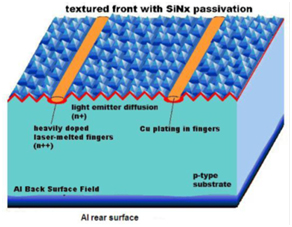UNSW has boosted the performance of its Laser Doping Selective
Emitter (LDSE) solar cell, a ground-breaking technology first developed by UNSW
engineers
The Technology
The LDSE technology utilizes the properties of a laser in the presence of a
phosphorus doping source to melt a silicon wafer. This process incorporates
phosphorus dopants into the molten silicon thereby exposing the silicon surface.
Subsequent self-aligned metal contact formation is achieved with light-induced
plating. Novel firing conditions used in the LDSE technology facilitate
the achievement of Voc values approaching 700mV on standard commercial grade
p-type CZ material.
Consequently, metal lines are only 20 microns wide, and have perfect
alignment to localised heavily doped regions. The antireflection coating is
retained in non-metallised regions and acts as a plating mask, providing
excellent surface passivation and antireflection qualities.
LDSE avoids degradation problems associated with high temperature thermal
processing; shading loss caused by wide lines, and eliminates the use of
expensive silver pastes.
Key Benefits
The advantages of UNSW’s patented LDSE solar cell technology are:
- Higher efficiency solar cells
- Lower production costs
- Suitable for mono - or multi-crystalline wafers
- Suitable for p-type and n-type wafers with either front or rear
junctions

Diagram
of a p-type LDSE solar cell
The Opportunity
LDSE technology can be retrofitted to Screen Print Lines, allowing
application of the technology readily achievable for commercial lines.
NewSouth Innovations is seeking licensees for the LDSE technology as well as
collaborative research partners to take the advanced LDSE technology for
double-sided and bifacial solar cells to market.